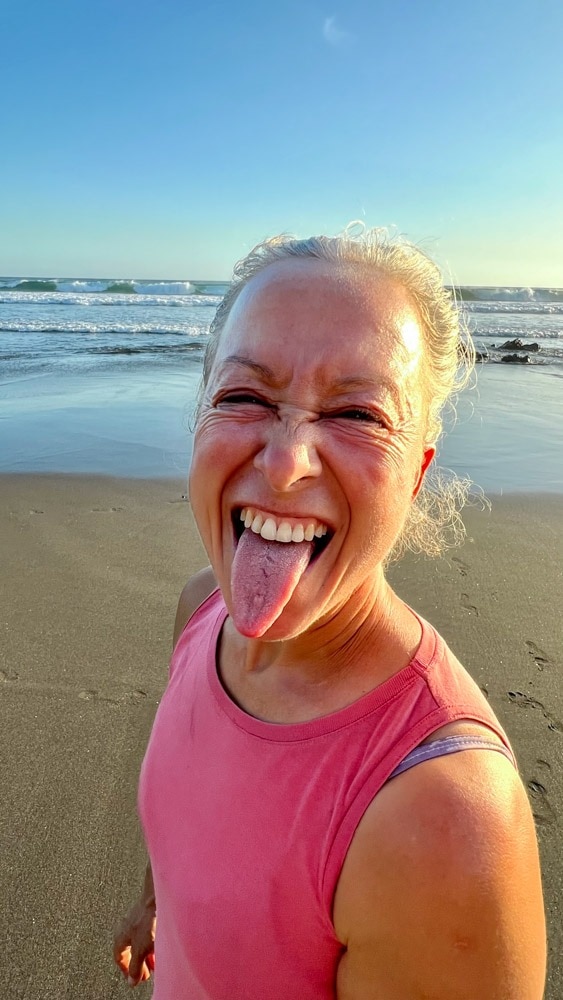In my previous post in this series, I shared some of the astounding facts about how your tongue and the way you swallow can create major impacts on your body and your health. Today, I’m writing about how you can assess your own tongue position, and giving you some of my favourite tongue exercises to get your swallowing super functional and healthy!
How’s YOUR Tongue Posture?
The obvious way to assess your habitual tongue position is simply to start noticing where your tongue rests in your mouth. If it pushes against your top front teeth or sits down at the bottom near your lower front teeth, it’s not in the right spot. Try to check into it multiple times over a day to get a true picture of where your tongue usually lives.
As well as this straightforward assessment, you can look for other clues that your tongue may have wayward tendencies.
First, try paying attention to your breath. Are your lips constantly parted? This is a common sign of mouth breathing. If you notice that you regularly breathe through your mouth, it’s quite possible that your tongue is not living in the right place.
Also, consider whether you have any of the typical symptoms related to poor tongue posture. Dental issues, including a gap between your front teeth or a cross-bite, tooth grinding or TMJD, headaches and neck pain are all possible signs.
If you find signs that your tongue does not habitually rest well behind your top front teeth, with the back pressing firmly into your palate, then I’d recommend getting further evaluated by a professional.
Tongue Exercises!
I have a list of 10-12 tongue exercises that I do daily to help me retrain my tongue and facial muscles. Here are a few of the most awesome ones for you to try.
Get Your Forward Head Back
‘Head forward’ position is not the most creative term, but it’s pretty easy to understand what it means: a position in which the head is held thrust forward of the body, and the chin is lifted into upward rotation.
When the head is constantly held forward, the weight of the head pulls on the back of the neck and shoulders, often leading to neck pains and headaches. It also makes it impossible to swallow correctly.
This simple exercise will help you slide your head back to where it belongs.
Put The Tip Of Your Tongue On The Spot
Here’s how to find the correct spot for the tip of your tongue:
Use the tip of your tongue to feel right behind your front teeth.
There is a flat area right behind the front teeth, then the ruggae (the bumpy part that almost feels like grooves in the sand on the bottom of the ocean). Feel for the most defined groove that will almost act like a step, after this the roof of the mouth should slope off into a deeper cave-like portion. Use the tip of the tongue to push into the back/top of the step. Boom! You have found the Spot.
A great way to practice getting your tongue on the Spot is to say the word ‘Boston’. The place your tongue rests when you say the ‘n’ in ‘Boston’ is exactly where you want it all the time.
As you get better at finding the Spot, you can practice keeping your tongue there more and more. Ask the tip of your tongue to start loving being on the Spot. Make your tongue get magnetically drawn there whenever your mouth is at rest (i.e. whenever you’re not talking or eating). Eventually this will become your default.
Practice A Better Swallow
To get the back of your tongue to its correct place, I like a tongue exercise called ‘the Cheezy Grin’. This one’s good because it will help you feel and sense the way the back of your tongue should move when you swallow.
Start by making your widest, cheeziest smile. Then raise your eyebrows high. Now, simply swallow (ideally without allowing your teeth to touch). Can you feel the back of your tongue pressing into the top back of your palate? Hopefully – that’s where you want it!
This is a great (albeit ridiculous) tongue exercise to work on your swallowing. Because you’re using it to retrain your brain, you’ll get far better results if you can do it frequently – ideally a couple of times an hour – until your neurology starts to get the hang of it.
Do You Have A Tongue Tie?
If you have a tongue tie, it is highly likely that your tongue doesn’t sit in the right place. You can do a basic check for whether you have a tongue tie like this:
Step One: Open your mouth as wide as you can (carefully if you have jaw/TMJ issues).
Step Two: Keeping your jaw still, reach the tip of your tongue up to try to touch the “Spot” behind your front teeth. How far does it get?
If you can touch the tip of the tongue to the Spot without having to close your mouth, congratulations on having an exceptionally stretchy tongue!
If your tongue can only reach about halfway up or lower, my amazing Oral Myofunctional Therapist, Geneva Kliman, recommends that you should start looking into getting a tongue-tie release (aka a frenectomy).
If you can get your tongue more than halfway but not all the way up, you still consider a tie release if you’re suffering in any way from the restricted tongue (with issues such as neck pain, clenching, snoring, low resting tongue posture, tongue thrust, and the other symptoms discussed in this post).
If you suspect that your baby has a tongue tie, here’s a great article with what to look for.
How To Find Help For Your Tongue!
Tongue position, breathing and swallowing are so important to your overall health! If you tried the assessments and exercises here and feel like you could use some work in this area, here’s what I’d suggest.
The exercises I’ve provided above are a great first step to help you improve your tongue position and breathing.
However, for best results, I highly recommend seeing an oral myofunctional therapist (OMT). OMTs are highly trained in helping you improve the function of your tongue, jaw and swallowing mechanics!
The problem is that oral myofunctional therapy is a relatively new field and even many dentists aren’t familiar with the value they can add to your health care.
Despite that, the first place to start asking is at your dentist or orthodontist. It’s quite possible that yours is progressive and following the latest airway research and can point you in the right direction. If not, then you’ve helped open their eyes to a new and valuable resource!
If your dentist can’t help, then you can try any of these three options:
- Online Registry Of Oral Myofunctional Therapists
- The Academy of Oral Myofunctional Therapy’s ‘Find An OMT’ link, or
- The Academy of Applied Myofunctional Sciences may also be able to help out.
If you know you have a tongue tie, here are two other great places to check out:
I’ve really benefitted from working with OMTs and I’d definitely recommend them to anyone seeking help for TMJ, grinding, sleeping and other similar issues!
Don’t Forget About The Rest Of You
Tongue position and swallowing is a game changer for the body! Isn’t it amazing how much this seemingly small thing can actually affect in a big, big way?
Incredibly, in addition to all the things I’ve listed above, your tongue position actually affects how strong your body is and your sense of balance! Your tongue truly is one of the most powerful secrets to better health! I’m continually amazed by how cool it is! And how simple but powerful the exercises I’m sharing can be.
But if you want relief from the neck and shoulder tightness that goes along with tongue stuff, there’s lots more you can do, too. Make sure to sign up for my newsletter where I share lots of exercises and wellness tips every week. And if you want some instant upper body happiness, try this class with some of my favourite neck pain relief moves. Enjoy!







